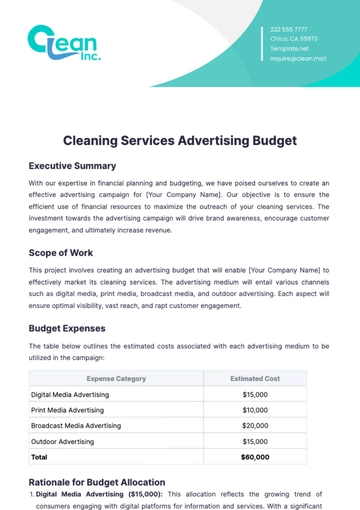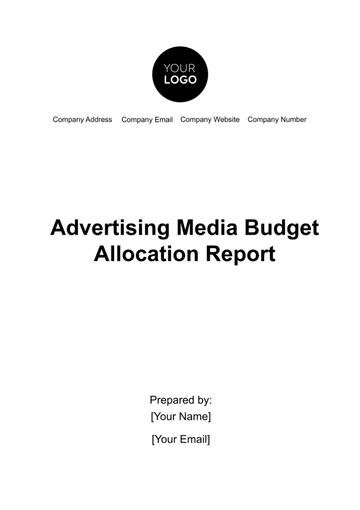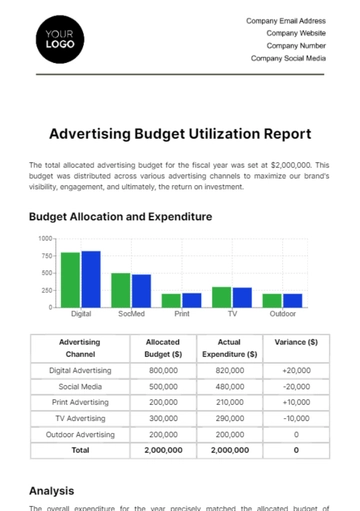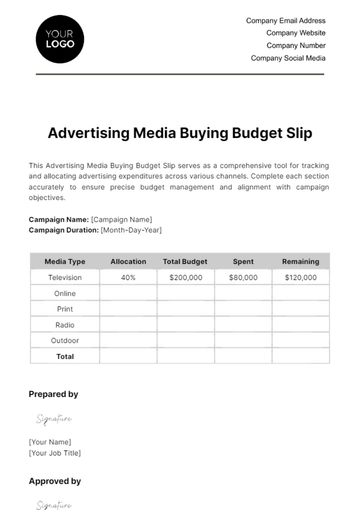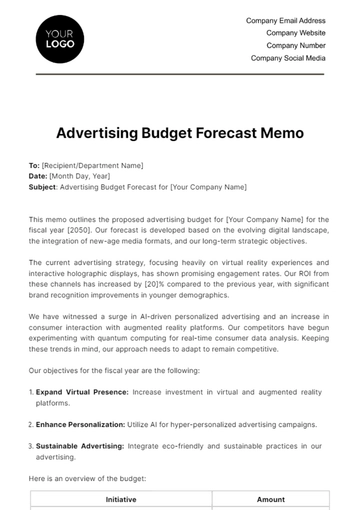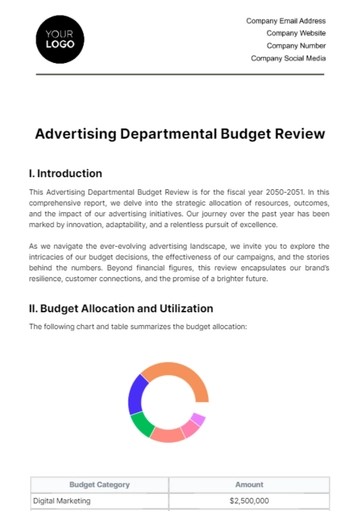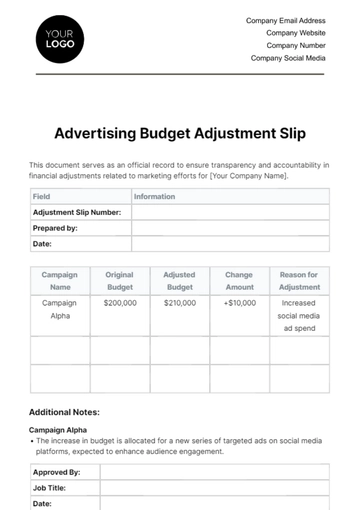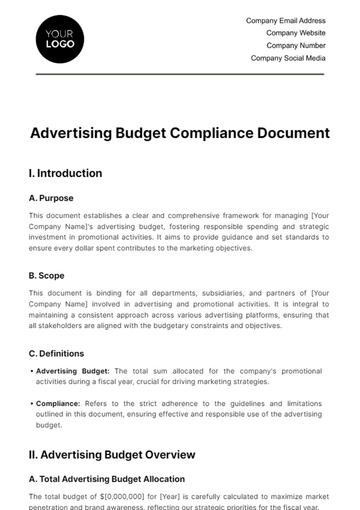Free Advertising Media Budget Allocation Report
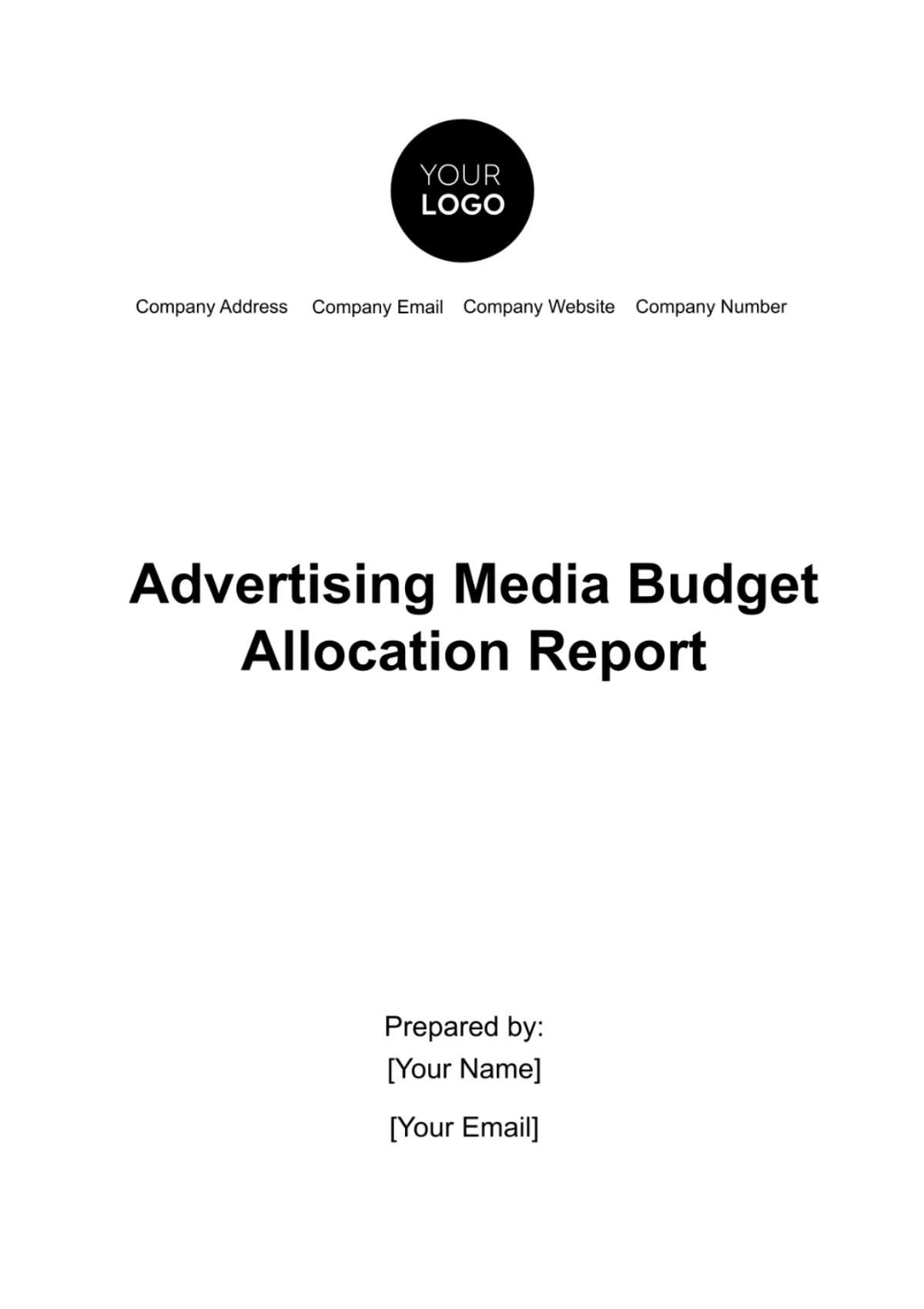
The primary goal of this report is to provide a detailed analysis and strategical suggestion of the allocations of budget in various Advertising Media channels. We conducted a comprehensive analysis of past trends, recent developments, and future predictions within the industry to provide a clear and organized report that your company can apply in making crucial budgeting decisions.
The right allocation of budget for distinct media channels can drastically enhance the reach and effectiveness of advertising campaigns. Therefore, a strategic, data-bound, and ROI-focused approach is necessary in making these monetary decisions.
I. Executive Summary
Purpose of the Report
The purpose of this Advertising Media Budget Allocation Report is to provide a succinct overview of the strategic distribution of financial resources across diverse advertising channels. It serves as a guiding document for key stakeholders involved in the planning and execution of advertising campaigns, offering clear insights into the rationale behind budget allocations and their alignment with overarching business objectives.
Key Findings
Within this section, pivotal findings are encapsulated, providing a snapshot of critical information. These findings include a concise evaluation of target audience analysis, the selection of media channels, budget allocation breakdown, and the anticipated return on investment (ROI). This section functions as a strategic compass, aiding decision-makers in comprehending the essence of the proposed budget allocation strategy and its potential impact on campaign success.
II. Campaign Objectives
Defined Goals
The campaign objectives serve as the compass guiding our strategic endeavors. They are meticulously crafted to encapsulate the essence of our overarching mission. Each defined goal is a beacon, illuminating the path towards realizing the vision we have set forth. Clear, measurable, and attainable, these goals establish the foundation upon which our advertising initiatives are constructed.
Strategic Objectives Alignment
Harmonizing with our broader organizational strategy, the campaign objectives are intricately woven into the fabric of our corporate vision. This section delves into the strategic alignment of our advertising goals, illustrating how each objective contributes to the fulfillment of our larger mission. By aligning our advertising objectives with the broader organizational strategy, we ensure not only the success of our campaigns but also a synergistic advancement towards our corporate aspirations.
III. Target Audience Analysis
Demographics
In-depth scrutiny of the target audience demographics serves as the cornerstone for our strategic media budget allocation. The following table presents a detailed breakdown of key demographic factors:
Demographic | Description |
Age Group | 18-24, 25-34, 35-44, 45-54, 55+ |
Gender | Male, Female, Other |
Income Level | Low, Middle, High |
Education | High School, College, Graduate School |
Behavior and Preferences
Understanding audience behavior and preferences is imperative for tailoring our message effectively. This section delves into behavioral aspects and preferences shaping our target audience's media consumption:
Online Behavior: Analysis of online activities, preferred platforms, and content consumption patterns.
Media Consumption Habits: Insights into preferred channels, devices, and time slots for media consumption.
Content Preferences: Identification of content types (e.g., informational, entertainment) that resonate with the target audience.
Channel Selection Rationale
The selection of media channels is intricately linked to the preferences and behaviors of our target demographic. This rationale is outlined based on the analysis of demographics, ensuring alignment with the audience's media consumption habits. The following factors influenced our channel selection:
Digital Media: Leveraging the online presence of our target demographic, with a focus on platforms most frequented by the specified age groups.
Print Media: Considering publications with readership aligning with the demographic's interests and information-seeking behavior.
Television: Selection of networks and programs catering to the preferred genres and time slots of the target audience.
Radio: Identifying stations and shows popular among the specified demographic for optimal reach and engagement.
This meticulous analysis ensures a targeted and informed approach to media channel selection, maximizing the resonance of our advertising efforts with the identified audience segments.
IV. Media Channel Selection
Digital Media
Platform Selection
In this section, we delve into the meticulous process of selecting digital platforms that align seamlessly with our campaign objectives. An exhaustive evaluation of popular platforms such as social media, search engines, and display networks is undertaken, considering factors like user engagement, targeting capabilities, and analytics.
Audience Reach
A comprehensive analysis of the potential audience reach within chosen digital platforms is conducted. This involves an intricate examination of user demographics, behaviors, and preferences, ensuring that the selected platforms resonate effectively with our target audience.
Print Media
Publication Selection
Within the realm of print media, a judicious selection of publications is paramount. This section outlines the criteria employed in choosing newspapers and magazines that possess the optimal readership demographics for our campaign. Circulation metrics and editorial content alignment are pivotal considerations.
Circulation Metrics
An in-depth exploration of circulation metrics is provided, shedding light on the geographical distribution, frequency, and volume of selected publications. This analysis is indispensable for gauging the potential exposure and impact of our advertising efforts.
Television
Network and Program Selection
The intricacies of television channel and program selection are scrutinized, emphasizing alignment with our campaign's narrative and target audience preferences. This section expounds on the decision-making process, encompassing factors such as viewership demographics, time slots, and program content relevance.
Viewer Demographics
A detailed examination of viewer demographics within chosen television networks is presented. This includes an exploration of age groups, socio-economic backgrounds, and viewing habits, ensuring that our advertising endeavors resonate authentically with the intended audience.
Radio
Station Selection
The art of selecting radio stations for optimal campaign impact is elucidated in this section. Considerations such as station format, geographic coverage, and audience engagement dynamics are meticulously weighed to ensure that our message reaches the ears of our target demographic effectively.
Listener Profiles
A comprehensive overview of listener profiles within chosen radio stations is provided. This encompasses an analysis of preferences, listening patterns, and geographic locations, affording us valuable insights into tailoring our advertising content for maximum resonance.
In essence, the Media Channel Selection section meticulously navigates the intricate landscape of diverse advertising mediums, providing a thorough rationale for the chosen channels and setting the foundation for a strategically sound advertising campaign.
V. Budget Allocation Breakdown
A. Overall Budget Distribution
The overarching financial framework of this advertising initiative involves a meticulous allocation of resources to ensure a balanced and impactful campaign. The following table provides a high-level summary of the overall budget distribution:
Media Channel | Allocation Percentage |
Digital Media | [00%] |
Print Media | [00%] |
Television | [00%] |
Radio | [00%] |
B. Channel-Specific Allocations
Digital Media Platform Selection
Our digital strategy encompasses targeted platforms that align with our audience profile and campaign objectives. The allocation for each platform is as follows:
Digital Platform | Allocation Percentage |
Social Media | [00%] |
Display Advertising | [00%] |
Search Engine Marketing | [00%] |
Audience Reach
In-depth analysis of audience reach metrics has informed the allocation strategy, ensuring a balanced presence across demographics and maximizing exposure within our target audience.
Print Media Publication Selection
The selection of print publications is driven by circulation metrics and audience relevance. The budget is distributed as follows:
Print Publication | Allocation Percentage |
Magazine A | [00%] |
Newspaper B | [00%] |
Trade Journal C | [00%] |
Circulation Metrics
Allocation decisions are underpinned by a comprehensive analysis of circulation metrics, optimizing exposure within the defined target demographic.
Television Network And Program Selection
Our television allocation is strategically distributed across networks and programs to ensure optimal visibility. The breakdown is as follows:
Television Network | Allocation Percentage |
Network X | [00%] |
Program Y | [00%] |
Special Events Z | [00%] |
VI. Justification and ROI Projections
Rationale For Chosen Allocations
The selected budget allocations have been meticulously determined based on a thorough analysis of the target audience, media channel effectiveness, and alignment with campaign objectives. Each allocation is justified by its capacity to maximize reach, engagement, and resonance with the identified audience segments.
Anticipated Return On Investment (ROI)
In forecasting the return on investment, projections are rooted in comprehensive data analytics and historical performance metrics. The following succinct summaries provide a glimpse into the envisaged ROI for each media channel:
Digital Media
The digital landscape, being inherently dynamic, is expected to yield a robust ROI driven by its precise targeting capabilities and expansive audience reach. Projections are anchored in past campaign successes, industry benchmarks, and evolving online behaviors.
Print Media
Print media's enduring influence is leveraged for its targeted reach to specific demographics. Anticipated ROI is grounded in historical response rates, subscriber engagement patterns, and the enduring credibility associated with well-established print publications.
Television
Television, as a visual storytelling medium, is poised to deliver a compelling ROI. Projections hinge on the strategic selection of networks and programs, tapping into the preferences of the identified audience, and historical viewership trends.
Radio
The radio's intimacy and local impact contribute to a projected ROI that reflects the targeted nature of this medium. Past success metrics, coupled with a nuanced understanding of listener profiles, guide the optimistic outlook for return on investment.
These ROI projections serve as a vital guidepost, aiding stakeholders in assessing the anticipated effectiveness of each chosen media channel within the broader context of the advertising strategy.
VII. Trends and Market Analysis
Industry Trends
Our comprehensive analysis of current industry trends reveals dynamic shifts that demand strategic attention. Emerging patterns suggest a notable surge in digital consumption, emphasizing the need for a robust online presence. Additionally, consumer preferences for interactive and personalized content underscore the significance of targeted engagement strategies.
Competitive Landscape
A thorough examination of the competitive landscape illuminates key players' strategies, highlighting successful approaches and potential pitfalls. Competitor initiatives in harnessing emerging platforms and innovative content distribution methods offer valuable insights for our own campaign optimization.
Market Conditions Impact
The market conditions assessment elucidates the impact of external factors on our advertising landscape. Economic indicators, societal changes, and technological advancements intertwine to create a dynamic environment. Understanding these influences guides our adaptive strategy formulation, ensuring resonance with the evolving market dynamics.
VIII. Measurement Metrics and KPIs
Key Performance Indicators (KPIs)
In this section, we define the Key Performance Indicators (KPIs) crucial for assessing the success of our advertising campaigns across different media channels. These indicators serve as benchmarks to gauge the effectiveness of our strategies and ensure alignment with overarching campaign objectives.
KPI | Description |
Reach | The total number of unique individuals exposed to our advertisements. |
Engagement Rate | Percentage of the audience actively interacting with our content. |
Conversion Rate | The ratio of converted leads to the total number of interactions. |
Click-Through Rate (CTR) | Percentage of users clicking on our digital ads compared to the total impressions. |
Brand Recall | The ability of the audience to remember our brand after exposure to advertisements. |
Measurement Metrics
To measure the performance of each media channel, we employ specific metrics tailored to their respective platforms. The table below provides a concise overview:
Media Channel | Measurement Metrics |
Digital Media | Impressions, Clicks, Conversion Tracking, Cost per Click (CPC), and Return on Ad Spend (ROAS). |
Print Media | Circulation Figures, Reader Engagement, and Coupon Redemption Rates. |
Television | GRPs (Gross Rating Points), Viewer Ratings, and Social Media Mentions. |
Radio | Listener Ratings, Call-In Responses, and Social Media Engagement. |
These metrics enable a comprehensive evaluation of our campaign's impact, allowing for informed adjustments to optimize resource allocation based on real-time performance data.
IX. Conclusion and Recommendations
Summary of Findings
In summarizing the comprehensive analysis presented in this report, it is evident that the meticulously crafted advertising media budget allocation strategy aligns with the predefined campaign objectives and target audience dynamics. The chosen media channels, encompassing digital, print, television, and radio, have been strategically identified to maximize reach and engagement.
Actionable Recommendations
Based on the findings and anticipating the dynamic nature of the advertising landscape, the following actionable recommendations are proposed:
Reallocation Flexibility: Maintain a degree of flexibility within the budget allocation framework to swiftly adapt to emerging trends or unforeseen shifts in audience behavior.
Continuous Monitoring: Implement a robust monitoring mechanism for key performance indicators (KPIs) and other relevant metrics across all media channels to ensure prompt identification of performance variances.
Adaptive Phasing: Consider an adaptive phasing strategy, allowing for iterative adjustments in budget distribution based on real-time campaign performance and market responsiveness.
Cross-Channel Synergy: Explore opportunities for synergies between different media channels to enhance the overall impact of the advertising campaign.
Post-Campaign Analysis: Conduct a thorough post-campaign analysis to derive insights for future planning, identifying successful strategies and areas for improvement.
By adhering to these recommendations, the advertising campaign stands poised for success, equipped with the agility to navigate the evolving landscape and capitalize on emerging opportunities.
This report offers an integrated approach that not only considers cost-effectiveness and maximum reach but also takes into account the unique identity and ethos of your brand. By carefully allocating your advertising budget, your campaigns will become a compelling narrative that draws consumers in and encourages them to engage with your brand.
- 100% Customizable, free editor
- Access 1 Million+ Templates, photo’s & graphics
- Download or share as a template
- Click and replace photos, graphics, text, backgrounds
- Resize, crop, AI write & more
- Access advanced editor
Maximize your advertising spend with Template.net's Advertising Media Budget Allocation Report Template. This editable and customizable report guarantees effective budget allocation, tailored to your marketing goals. Editable in our Ai Editor Tool, it helps streamline your advertising strategy. Employ this compelling tool and experience a boost in your marketing efficiency, empowering successful campaigns. Try it today!
You may also like
- Budget Sheet
- Personal Budget
- Non Profit Budget
- Monthly Budget
- Project Budget
- HR Budget
- Company Budget
- Home Budget
- Weekly Budget
- College Budget
- Business Budget
- Construction Budget
- Small Business Budget
- Hotel Budget
- Annual Budget
- Home Renovation Budget
- Household Budget
- Student Budget
- Grocery Budget
- Marketing Budget
- Corporate Budget
- Startup Budget
- Manufacturing Budget
- Church Budget
- University Budget
- Annual Budget Plan
- Event Budget
- Operating Budget
- Travel Budget
- Food Budget
- IT and Software Budget
- School Budget
- Real Estate Budget
- Sales Budget
- Conference Budget
- Budget Finance
- Freelancer Budget
- Budget Advertising
